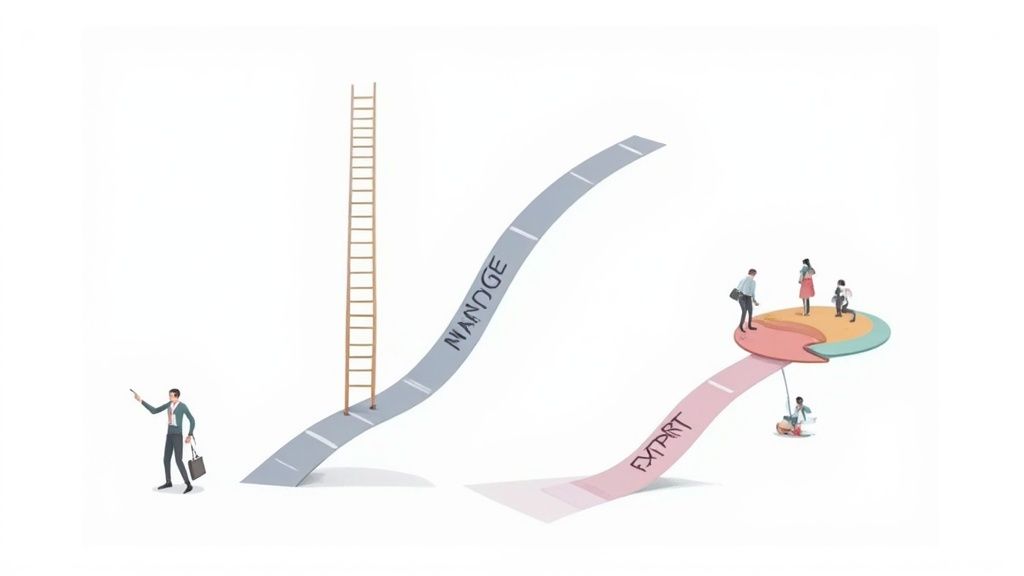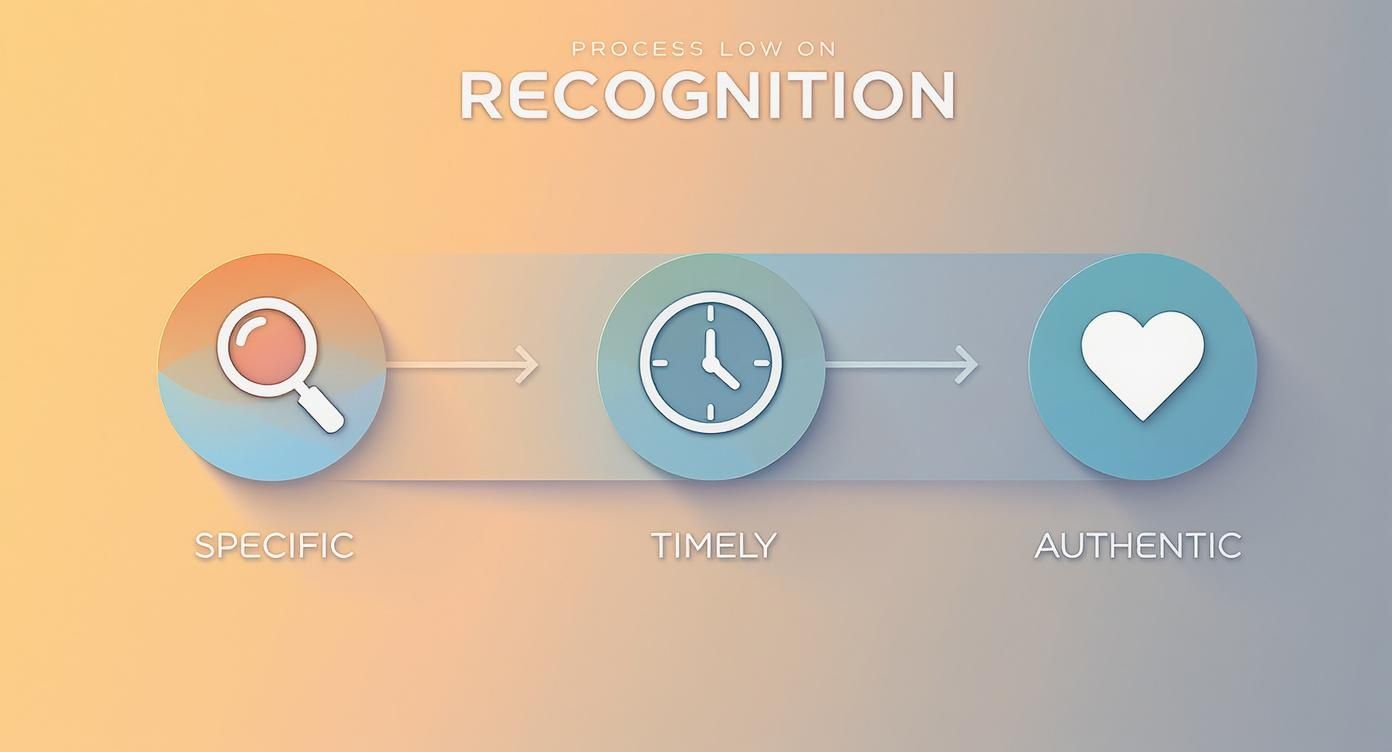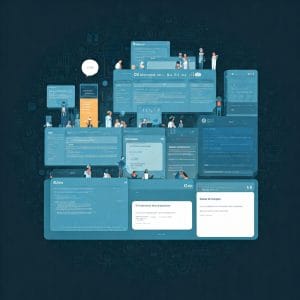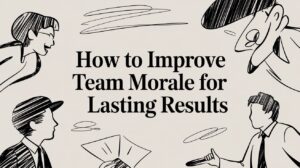If you want to keep your best people, you need a game plan built on real career growth, good managers, and genuine, consistent recognition. It’s easy to get fixated on turnover rates, but the smart move is to look for the subtle signs of disengagement that show up long before someone quits. That’s how you build a place people genuinely don’t want to leave.
Table of Contents
Why Your Best People Are Quietly Disengaging
The whole conversation around employee retention is changing. For years, we obsessed over the cost of turnover—the recruiting and training expenses. That’s still a big deal, but there’s a more immediate and insidious problem afoot: “The Great Detachment.” This is the quiet crisis where your top talent checks out mentally months before they ever hand in their resignation. This silent disengagement is a creativity killer, a productivity drain, and it poisons team morale far more than an empty desk ever could.

The data backs this up. This is no longer just an HR problem; it’s a fundamental business challenge. Retention remains the top workforce headache, with 66% of HR executives citing it as their biggest concern. Moreover, over half of operations executives now view high turnover as a significant business obstacle, not just a personnel issue.
The Silent Productivity Killer
I’ve seen this happen firsthand. A tech company couldn’t figure out why its product development cycles were getting longer and longer, even though its turnover rate was stable. Collaboration felt forced. Brainstorming sessions were quiet. The spark was just… gone.
That’s the classic sign of detachment. People are physically present but no longer invested. They’re doing the bare minimum, avoiding risks, and holding back the discretionary effort that truly drives a business forward. This is what happens when their basic needs for growth, connection, and feeling valued are ignored.
The most expensive employee isn’t the one who leaves. It’s the one who stays and is mentally checked out. Their disengagement is contagious and quietly torpedoes the entire team’s potential.
Spotting the Early Warning Signs
The first step to keeping your people is learning to read the room and spot these indicators before they turn into resignations. You have to pay attention to the human side of work—the stuff that typical performance metrics completely miss. For a deeper dive into this, the guide on How to Improve Employee retention: The Complete UK Strategy provides a fantastic framework.
Here’s what to look for:
- Reduced Initiative: That go-getter who always volunteered for new projects? They’re now sticking strictly to their job description.
- Silence in Meetings: Team members who once pushed back and shared bold ideas have become passive observers.
- Increased Isolation: You notice a drop in casual chats and collaboration, especially in remote or hybrid teams. The social glue is dissolving.
- Lack of Peer Recognition: A team that stops celebrating each other’s wins is a team that’s losing its connection. Simple, consistent recognition is a powerful antidote here. A practical example is a team that used to give kudos in their Slack channel constantly, but now the channel is silent. This silence is a major red flag that team morale is dropping.
Catching this quiet disengagement is half the battle. Now, let’s dive into the playbook for diagnosing these problems and implementing strategies that re-engage your team and make them excited to stay for the long haul.
Moving from Guesswork to a Clear Diagnosis
To truly improve employee retention, you must stop guessing why people are leaving. Too many leaders throw solutions at the wall to see what sticks—a salary bump here, a team lunch there—and then wonder why turnover rates don’t budge. They’re treating symptoms, not the actual disease.
A proper diagnosis is the only way to shift from generic perks to surgical, high-impact fixes.
Imagine you discover your turnover problem isn’t company-wide at all. Instead, it’s concentrated in one specific team, and almost exclusively among employees with 12-18 months of tenure. That single insight changes everything. Suddenly, you realize your problem isn’t compensation; it’s a broken or nonexistent career path for mid-level staff in that department. Without digging into the data, you’d never have uncovered that crucial detail.
Uncovering the Truth with Better Data Collection
Gathering honest, actionable data is the bedrock of any real retention strategy. This means going beyond surface-level questions and opening up channels where employees feel safe enough to share the unvarnished truth. Your goal is to collect both qualitative and quantitative information that points you directly to the problem areas.
Here are three ways I’ve seen companies get the data they actually need:
- Revamp Your Exit Interviews: Stop treating these like a simple HR checklist. Turn them into investigative journalism. A practical example is asking “What was the final straw that made you start looking for a new job?” instead of “Why are you leaving?”. The first question gets a more specific, actionable answer. Have a neutral third party, like a respected senior leader from another department, conduct the conversation. You’ll get far more candid feedback.
- Design Engagement Surveys People Actually Want to Complete: Short, frequent pulse surveys are infinitely more effective than a massive annual questionnaire that everyone dreads. Ask specific, targeted questions tied to known retention drivers: recognition, career growth, manager support. A high response rate to a five-question monthly survey gives you much more current and relevant data than a low response rate to a 50-question annual beast.
- Analyze Your Existing HR and Performance Data: Look for the hidden patterns. Are your top performers leaving at a higher rate than everyone else? Is there a spike in resignations three months after performance reviews? When you combine this hard data with your survey feedback, you can uncover powerful correlations you would have otherwise missed.
From Raw Data to Actionable Insights
Once you have the data, the real work begins: finding the story it’s telling. Just looking at your company-wide average turnover rate is dangerously misleading. The most valuable insights come from slicing and dicing your findings to pinpoint exactly where and why the bleeding is happening.
A landmark study by Gallup found that companies where more employees had “best friends” at work experienced 7% more engaged customers and 12% higher profit. This is a perfect example of how interpersonal connections—something you can actually measure—directly impact business outcomes and retention.
Think of yourself as a detective looking for clues. Start segmenting the data in different ways and see what patterns jump out.
Where to Start Slicing Your Data:
| Segment By | What It Might Reveal | Potential Action |
|---|---|---|
| Manager | High turnover is isolated to one or two specific managers. | Provide targeted coaching or leadership training for those individuals. |
| Department | The engineering team has a much higher attrition rate than marketing. | Investigate workload, tools, or career paths specific to that department. |
| Tenure | A significant number of employees leave between years one and two. | Re-evaluate the onboarding process and the clarity of career progression for junior roles. |
| Location | One office has much lower engagement scores than the others. | Explore local leadership, culture, or resource disparities. |
This process is how you transform a vague, overwhelming problem like “high turnover” into a specific, solvable challenge like, “We need to improve the career development path for our junior sales team in the London office.”
This level of clarity is the difference between guessing and knowing. It’s the only way to build a retention strategy that will actually work for the long haul.
Building Career Paths People Want to Follow
A dead-end job is one of the fastest ways to lose good people. When your most talented and ambitious employees can’t see a future with you, they’ll start looking for one with someone else. Creating clear, compelling career pathways isn’t just an HR box to tick; it’s a core retention strategy that shows your team you’re genuinely invested in their long-term growth.
It’s about making it crystal clear that there’s a path forward, not just a path out.

The connection between professional development and loyalty is impossible to ignore. A staggering 93% of employees say they are more likely to stay with a company that invests in their career. The benefits hit the bottom line, too. Organizations that get this right often see a 22% boost in profitability, while those that don’t risk losing one in three new hires in the first year alone. For more on this, check out this comprehensive analysis of employee retention statistics.
This isn’t just about saving on recruitment costs; it’s about building a more profitable and stable business from the inside out.
Blueprinting Your Career Ladders
First things first, you need to demystify what career progression actually looks like at your company. Your team shouldn’t have to guess what it takes to get to the next level. This is where a competency matrix is your best friend. It’s essentially a simple grid that lays out the specific skills, behaviors, and responsibilities required for each role in a department, from entry-level to senior positions.
For instance, a marketing team’s matrix might map out roles like this:
- Marketing Coordinator: The focus is on execution. Key skills include social media scheduling, deploying email campaigns, and pulling basic analytics reports.
- Marketing Specialist: This role starts to lean into strategy. Competencies involve campaign planning, running A/B tests, and audience segmentation. They also begin mentoring junior coordinators.
- Senior Marketing Manager: This person leads the charge on major initiatives. The required skills shift to budget management, cross-functional project leadership, and setting team-wide KPIs.
This kind of clarity gets rid of all the ambiguity. An employee can look at the matrix and know exactly what they need to work on. It transforms career conversations from vague, subjective chats into objective, collaborative planning sessions between an employee and their manager.
The Power of the Dual-Track Career Path
Here’s a classic mistake: assuming every top performer wants to become a manager. Forcing them down that road is a recipe for disaster, where you lose a brilliant individual contributor and gain a miserable, ineffective manager.
The solution is a dual-track career path. This creates two parallel ladders for advancement, giving people a real choice.
One track is for people management, focusing on skills like coaching, hiring, and team leadership. The other is for individual contributors (ICs), rewarding deep technical expertise, innovation, and mentorship. Critically, both paths must offer equivalent prestige, compensation, and influence in the company.
I once worked with a marketing agency that was bleeding senior creative talent. Their best designers and copywriters felt stuck because the only way “up” was to become a manager, which meant spending less time on the creative work they loved. By introducing a dual-track system, they created a “Principal Creative” role with the same salary band as a “Creative Director.” This simple change cut voluntary turnover among their senior creatives by over 40% in 18 months.
Fueling Growth with Upskilling and Mentorship
Once you’ve defined the paths, you have to help people walk them. This means getting serious about funding upskilling initiatives and building mentorship programs that actually make a difference.
Securing buy-in for a training budget can be a challenging task, but framing it as a retention investment is the most effective approach. Show leadership the numbers—the cost of replacing a key employee versus the cost of a few online courses or a certification. The math almost always favors development.
Mentorship programs are another powerful, low-cost tool. But they need structure to succeed. Don’t just pair people up and hope for the best.
Keys to an Effective Mentorship Program:
- Set Clear Goals: What’s the point of the program? Is it for skill development, navigating company culture, or leadership training? Define its purpose from the start. A practical example is a program specifically designed to help junior engineers learn the company’s codebase from a senior developer.
- Provide a Framework: Give mentors and mentees a simple guide with suggested discussion topics for their first few meetings. It helps break the ice and gets the conversation rolling.
- Recognize the Mentors: Mentoring is extra work on top of a busy job. Acknowledge these leaders publicly and make sure their mentorship contributions are considered during performance reviews.
By building these clear pathways and backing them up with real resources, you completely change the conversation from, “What’s my next job?” to, “What’s my next step here?”
The Undeniable Power of Team Recognition
While a clear career path gives your team a map for the future, recognition is the fuel that keeps them engaged and motivated along the way. It’s so easy to write this off as a “soft skill” or a nice-to-have, but that’s a seriously expensive mistake. A genuine culture of appreciation is one of the most powerful—and cost-effective—levers you have for keeping your best people.
The importance of team recognition can’t be overstated. It reinforces the exact behaviors you want to see, strengthens social bonds, and makes employees feel psychologically safe and valued. When people see good work being celebrated, it clarifies what success looks like and motivates everyone to aim higher. We’re not talking about those stale ’employee of the month’ programs; the real magic happens when you shift from a once-a-year event to a daily, ingrained behavior that tightens the bonds between team members.
The Psychology of Feeling Valued
At its core, recognition taps into a fundamental human need: we all want to feel seen and know that our work matters. When people feel truly appreciated, it triggers a powerful psychological chain reaction. It validates their hard work, boosts their confidence, and deepens their connection to their colleagues and the bigger company mission.
The numbers don’t lie. A sobering 66% of employees say they would probably quit if they felt unappreciated. Pair that with another stat—that 65% of people feel unrecognized at work—and you can see the massive disconnect. This gap isn’t a problem; it’s a huge opportunity for any leader willing to make appreciation a real priority.
When you make people feel seen, they don’t just feel better—they perform better. Recognition is the currency of human connection at work, and a consistent flow of it is non-negotiable for building a team that stays.
Making Recognition Specific, Timely, and Authentic
The impact of any praise lives or dies in the delivery. For recognition to actually land and mean something, it has to be built on three simple principles: it must be specific, timely, and authentic.
Vague praise like “good job” is nice, but it’s completely forgettable. To make it stick, you have to connect the praise directly to a specific action and the positive result it created.
- Be Specific: Don’t just say, “Thanks for your help on the project.” Instead, a practical example would be: “Thank you for catching that data error in the Q3 report before it went to the client. Your attention to detail saved us a ton of rework and made our team look great.” See the difference?
- Be Timely: Recognition loses its punch the longer you wait. Acknowledge great work as close to the moment as you can. A quick shout-out in a team chat right after a killer presentation is worlds more effective than a brief mention in a monthly newsletter three weeks later.
- Be Authentic: People have a built-in radar for insincere praise. Recognition must be genuine and reflect what your company truly values. It can come from anywhere—peers, managers, leaders—as long as it’s real.
From Annual Reviews to Daily Rituals
The companies that nail retention are the ones that weave recognition into the very fabric of their daily work. They create simple, easy-to-use rituals that make giving and receiving appreciation feel like a natural part of the day.
Take a real-world example from a customer support team that was bleeding talent. They decided to create a simple #kudos channel in their Slack workspace. The rules were dead simple: anyone could give a public shout-out to a colleague for anything, big or small. It could be for handling a tough customer call with grace or just helping a teammate troubleshoot a weird technical bug.
Within a few weeks, that channel was one of the most active in their entire company. It wasn’t a top-down mandate; it was a peer-to-peer celebration of the small wins that happen every day. Six months later, they had slashed voluntary turnover in that department by over 30%. The simple, consistent act of recognizing each other’s efforts rebuilt team morale and made people feel like they were part of a supportive team.
If you’re looking for more inspiration, you can explore a whole range of creative employee appreciation ideas to find rituals that fit your team’s vibe.
Recognition Strategies: High vs Low Impact
Not all recognition is created equal. Some of the most common tactics can actually backfire, breeding more cynicism than motivation. It’s crucial to focus your energy on what actually works.
| Strategy | Why It Works (Or Fails) | Impact Level |
|---|---|---|
| Peer-to-Peer Slack Shout-outs | Empowers everyone to recognize good work, making it timely, frequent, and democratic. It actively reinforces team collaboration. | High |
| Specific Manager Feedback | Directly links an employee’s actions to business outcomes. It serves as valuable real-time coaching and reinforces positive behaviors. | High |
| ‘Employee of the Month’ Award | Often seen as a popularity contest or a simple rotation, failing to recognize consistent, quiet contributors. This can demotivate the rest of the team. | Low |
| Generic Annual Bonuses | People see this as part of their compensation package, not as genuine appreciation for specific achievements. The link to performance is too weak. | Low |
By focusing on these high-impact, low-cost rituals, you can transform recognition from a formal, infrequent event into a powerful, continuous current of positive reinforcement. That’s how you build a workplace people don’t want to leave.
Putting Your Retention Strategy into Action
A brilliant retention plan is just an idea until you put it into practice. To truly move the needle, you have to bring your recognition and feedback strategies out of the boardroom and into your team’s daily life. This is where tools that live inside your workflow, like AsanteBot for Slack, make all the difference. They help turn good intentions into consistent, culture-building habits.
When you operationalize your strategy, recognition stops being an afterthought and becomes a visible, daily ritual. It’s a subtle shift, but it’s how you build a culture of appreciation from the ground up, making it easy and natural for your team to celebrate each other.
Setting Up Your Recognition Engine
First things first, you need a dead-simple way for people to give peer-to-peer recognition. When giving a shout-out is just a few clicks away, you’ll see participation go through the roof. With a tool like AsanteBot, you can build this system right inside Slack, which means no one has to log into a separate app or learn a clunky new process.
A key part of the setup—and this might sound strange—is to cap the number of recognitions a person can give each day. For example, limiting everyone to five “props” per day creates a sense of value. It encourages people to give more thoughtful, high-quality shout-outs instead of just spamming emojis. It keeps the whole system meaningful.

This process is all about moving beyond a generic “good job.” You want acknowledgments that are specific, timely, and genuinely felt. That’s what builds real connection and makes people want to stay.
Fostering Friendly Competition and Tangible Rewards
Once the basics are in place, it’s time to add a few layers to really get things buzzing. Leaderboards are a fantastic way to visualize who’s participating and spark a little friendly competition. By showing both the top givers and top receivers, you encourage everyone to get involved and you publicly celebrate your biggest culture champions.
The next step is to connect all those recognition points to actual, tangible rewards. This is what closes the loop and gives the system real-world value. The rewards don’t need to break the bank; they just need to be things your team genuinely cares about.
- Customizable Rewards: Let people redeem points for things they’ll actually use, like a small gift card to their favorite coffee shop, an extra day off, or a donation to a charity they support.
- Experience-Based Perks: Think about rewards that offer professional value, like a one-on-one lunch with a senior leader or the chance to spearhead a small passion project. These cost very little but can be huge for someone’s career development.
For many companies, especially small and mid-sized ones, a solid retention strategy needs to be part of a bigger HR picture. Reading up on a comprehensive human resources guide for small businesses can help you make sure your rewards program is structured effectively.
Tying recognition to real rewards is a powerful signal. It tells your team you’re serious about investing in a positive culture and turns appreciation into a tangible asset, not just a nice-to-have.
Building a Cadence for Constructive Feedback
Recognition is one half of the equation; structured, constructive feedback is the other. Too many teams let feedback pile up for the dreaded annual review, where it’s often too little, too late. A much better approach is to build a regular, lightweight feedback ritual.
Something like a “Feedback Friday” or “Wins Wednesday” can be a total game-changer. With a tool like AsanteBot, you can automate a weekly prompt in a Slack channel, asking people to share a win or give a shout-out to a helpful colleague. It creates a predictable, positive moment for everyone to reflect and connect.
Here’s a simple “Feedback Friday” template you could use:
- What was your biggest win this week? (Promotes self-reflection and celebrates individual progress.)
- Who on the team helped you get it done? (Sparks peer recognition and highlights collaboration.)
- What’s one thing you learned? (Helps build a culture of continuous learning.)
By automating these simple prompts, you create a powerful weekly habit that strengthens your culture, boosts morale, and reinforces team bonds. These rituals also pair perfectly with other team-building efforts. If you need more ideas, check out these virtual team building activities that can really complement a strong recognition culture.
Answering Your Employee Retention Questions
Even with the best playbook, questions will pop up once you start putting a retention strategy into practice. Building a workplace where people genuinely want to stay isn’t a “set it and forget it” project; it’s an ongoing commitment. Let’s dig into some of the most common questions I hear from leaders as they start this work.
Getting clear on these points from the outset will help you sidestep common roadblocks and keep things moving in the right direction.
What’s the Single Most Effective Retention Strategy?
If I had to pick just one thing, the strategy that gives you the most bang for your buck is investing in the quality of your managers. Nothing else comes close. A manager has the most direct, day-to-day impact on an employee’s experience, their sense of value, and their future at the company.
Think about it from your own experience. A great manager is like a force multiplier. They can make up for temporary frustrations like a heavy workload or slightly-off compensation because they go to bat for their team, give real feedback, and are genuinely invested in their people’s success. On the flip side, a bad manager can sour a dream job and chase off even your highest-paid, most motivated employees. Training your managers to be great coaches is the highest-leverage move you can make.
How Long Until We See Results?
You’ll see progress in two waves: the early signs and the hard numbers.
The early signs—what we call leading indicators—can pop up pretty quickly, often within 3 to 6 months. This is the stuff that tells you you’re on the right track.
- You’ll see more people using your new recognition programs.
- Pulse survey comments will start to sound more positive.
- You’ll notice more spontaneous “thank yous” and shout-outs in your public channels.
The hard numbers, or lagging indicators, take longer. A real, measurable drop in your voluntary turnover rate—the ultimate goal—usually takes anywhere from 9 to 18 months to show up consistently in the data. You have to track both to get the full story.
Don’t panic if your turnover numbers don’t budge in the first six months. Watch the leading indicators. If engagement is up and people are participating, you’re building the right foundation. The retention data will follow.
What Are Some Low-Cost Ways to Improve Retention?
“We’re on a tight budget but can’t afford to lose our best people. Where do we start?” This is a great question because so many high-impact retention boosters don’t require a huge budget.
Here are a few ideas that cost more in effort than in dollars:
- Build a Recognition Habit: This is the lowest-hanging fruit. A dedicated Slack channel for peer-to-peer shout-outs costs exactly $0 but does wonders for morale. It makes appreciation visible and contagious. A practical example is starting every weekly team meeting by having each person give a shout-out to a colleague who helped them that week.
- Fix Your 1-on-1s: Get serious about the quality of conversations between managers and their reports. Give managers a simple guide to shift these meetings from boring status updates to meaningful talks about career goals, challenges, and feedback.
- Lean into Flexibility: In today’s world, flexibility is currency. Offering flexible hours or hybrid options is one of the most sought-after perks, and it often has very little direct cost to the business.
- Show Them the Path Forward: Just taking the time to map out what a career path looks like for different roles gives people clarity and a reason to stick around. It shows them there’s a future. This is an investment of time, not money.
Focusing on these foundational pieces can create a much better work environment and seriously improve retention without blowing up your budget.
Ready to turn recognition into a daily habit? With AsanteBot, you can launch a peer-to-peer recognition program, create custom rewards, and build a culture of appreciation right inside Slack. Get started in two minutes at https://asantebot.com.




